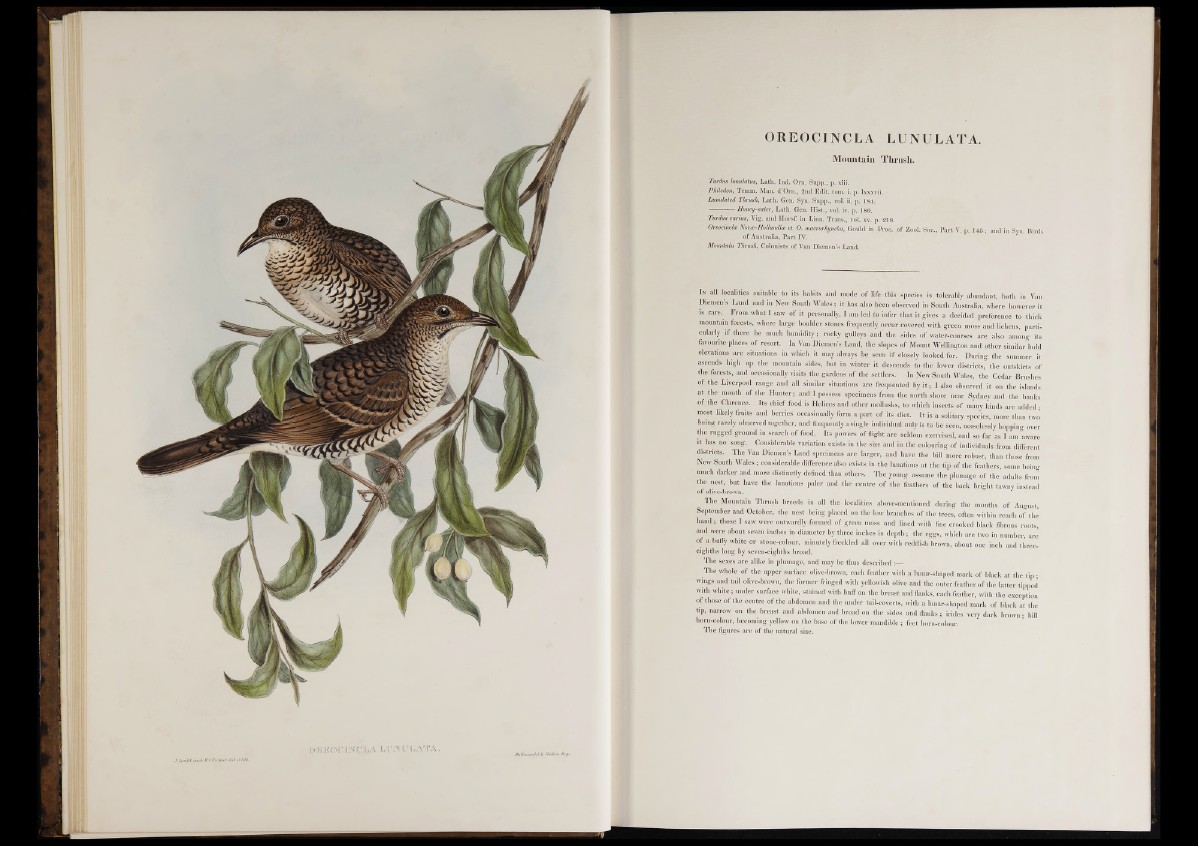
OREOCINCLA LUNULATA.
Mountain Thrush.
Turdus lumlatus, Lath. Ind. Orn. Supp., p. xlii.
Philedon, Temm. Man. d’Orn., 2nd Edit. tom. i. p. IxxxviL <’
Lunulated Thrush, Lath. Gen. Syn. Supp., voli ii. p. 184.
-----------Honey-eater, Lath. Gen. Hist., vol. iv. p. 180.
Turdus varius, Vig. and Horsf. in Linn. Trans., vol. xv. p. 218.
Oreocincla Nmx-HoBandue e t 0. macrorkt/ndia, Gould in Proc. ¡of Zool. Soc., Part V. p. 146 j and in Syn. Birds
of Australia, Part IV.
Mountain Thrush, Colonists of Van Diemen’s Land.
In all localities suitable to its habits and mode o f lifj this-; species g j tolerably abundant, both in Van
Diemen’s Land and in New South Wales; it has also been observed in South Australia, where however it
is rare. From what I saw of it personally, I am led to infer that it gives a decided preference to thick
mountain forests, where large boulder stones frequently occur Covered with green moss and lichens, particularly
if there be much humidity; rocky gulleys and' the sides o f water-courses are also among its
favourite places o f resort. In Van Diemen's Land, the slopes of Mount Wellington and other similar bold
elevations are situations in which it may always be seen if closely looked for. During the summer it
ascends high up the mountain sides, but in winter it descends to the lower districts, the outskirts of
the forests, and occasionally visits the gardens of the settlers. In New South Wales, the Cedar Brushes
o f the Liverpool range and all similar situations are frequented bV i t ; I also observed it on the islands
at the mouth o f the Hunter; and I possess specimens from the north shore near Sydney and the banks
of the ^ Clarence. Its chief food is Helices and other mollnsks, to which insects of many kinds are added;
most likely fruits and berries occasionally form a part of its diet. It is a solitary species, more than two
berag rarely observed together, and frequently asingle individualoily is to be;|be«noiselessly hopping over
the rugged ground in search of food. Its powers of flight aré seldom exercised, and spJhriUs I am aware
it has no song. Considerable variation exists in the size and in the colouring of individuals from different
districts. The Van Diemen’s Land specimens are larger, and have the bill more robust, than those from
New South Wales; considerable difference also exists in the lunations at the tip of the feathers, some being
much darker and more distinctly defined than others. The young assume the plumage of the adults from
the nest, but have the lunations paler and the centre o f the feathers of the back bright tawny instead
o f olive-brown.
The Mountain Thrush breeds in all the localities above-mentioned during the months o f August,
September and October, the nest being placed on the low branches o f the trees, often within reach of the
hand ¡ those I saw were outwardly formed of green moss and lined with fine crooked black fibrous roots,
and were about seven inches in diameter by three inches in depth; the eggs, which are two in number, aré
o f a huffy white or stone-colour, minutely freckled all over with reddish brown, about onSifnch and three-
eighths long by seven-eighths broad.
The sexes are alike in plumage, and may be thus described:—
The whole of the upper surface olive-brown, each feather With a lunar-shaped mark o f black at the tip ;
wings and tad olive-brown, the former fringed with yellowish olive and the outer feather o f the latter tipped
with white | under surface white, stained with buff on the breast and flanks, each feather, with the exception
o f those o f the centre o f the abdomen and the under tail-coverts, with a lunar-shaped mark o f black at the
tip, narrow-on the breast and abdomen and broad on the sides ahd flanks ¡ irides very dark brown ¡ bill
horn-colour, becoming yellow on the base of the lower mandib%.feet horn-colour.
The figures are o f the natural size.